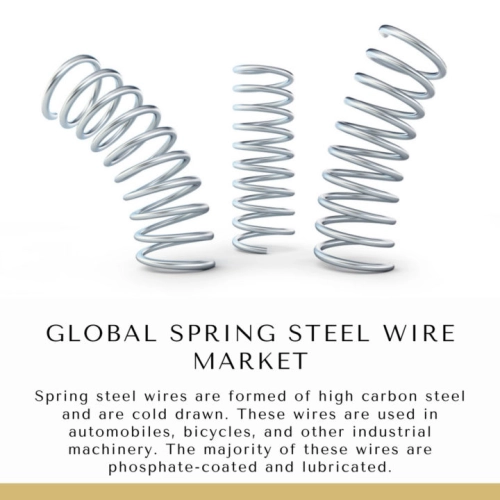
- Get in Touch with Us

Last Updated: Apr 25, 2025 | Study Period: 2024-2030
INTRODUCTION
Spring steel wires are formed of high carbon steel and are cold drawn. These wires are used in automobiles, bicycles, and other industrial machinery. The majority of these wires are phosphate-coated and lubricated.
Carbon spring steel wire is formed from carbon structural steel or carbon tool steel wire rod of high carbon grade. According to the spring's purpose, the chemical composition, gas concentration, and non-metal inclusion must all be strictly managed.
The most common steel wires used in spring manufacture are high carbon spring steel wires. They are cost-effective, sturdy, and long-lasting.
Spring steels with a high carbon content are the most often utilised of all spring materials. Despite being the cheapest, they will meet your spring steel material criterion in preference to others. High carbon spring wires are widely available, simple to work with, and widely used. High or low temperatures, as well as shock or impact loads, are not suitable for these materials.

Alloy spring steels have a specific niche in spring materials, especially in high-stress situations and applications involving shock or impact loading.
Alloy spring steels can also endure higher and lower temperatures than high-carbon steels, and they can be ordered annealed or pre-tempered.
Because of their strong electrical characteristics and excellent corrosion resistance, copper-base alloys are useful spring materials. Despite being more expensive than high-carbon and alloy steels, these materials are extensively employed in electrical components and at subzero temperatures.
The Global Spring Steel Wire Market accounted for $XX Billion in 2023 and is anticipated to reach $XX Billion by 2030, registering a CAGR of XX% from 2024 to 2030.
Steel spring wire is available in a variety of carbon and stainless steel alloys, nickel alloys, and red metals. Carbon steel music wire, phosphate coated music wire, Corrostan electro galvanised zinc coated, Preco z â zinc plated, oil tempered MB spring wire are all examples of spring wire.
Wires for fasteners, springs, surgical instruments, windings, optical, musical, and lighting applications are manufactured in conventional and custom sizes.
Materials used include copper or nickel alloys, aluminium, carbon steel, and stainless steel. Flat, round, square, triangle, diamond, and custom wire shapes are available. The aerospace, automotive, electronics, and medical industries are all served by this company.
Linyi Zhengjun Building Materials Co., Ltd. is a manufacturing company that specialises in low carbon cold drawing wire, construction mesh, Shu Le plate mesh, electric welding mesh, steel mesh, building template, iron nails, and other building materials.
Gibbs Interwire is an processor and distributor of Stainless Steel, Carbon Steel, Nickel Alloys, and Red Metal Strip Coil and Wire.
| Sl no | Topic |
| 1 | Market Segmentation |
| 2 | Scope of the report |
| 3 | Abbreviations |
| 4 | Research Methodology |
| 5 | Executive Summary |
| 6 | Introduction |
| 7 | Insights from Industry stakeholders |
| 8 | Cost breakdown of Product by sub-components and average profit margin |
| 9 | Disruptive innovation in the Industry |
| 10 | Technology trends in the Industry |
| 11 | Consumer trends in the industry |
| 12 | Recent Production Milestones |
| 13 | Component Manufacturing in US, EU and China |
| 14 | COVID-19 impact on overall market |
| 15 | COVID-19 impact on Production of components |
| 16 | COVID-19 impact on Point of sale |
| 17 | Market Segmentation, Dynamics and Forecast by Geography, 2024-2030 |
| 18 | Market Segmentation, Dynamics and Forecast by Product Type, 2024-2030 |
| 19 | Market Segmentation, Dynamics and Forecast by Application, 2024-2030 |
| 20 | Market Segmentation, Dynamics and Forecast by End use, 2024-2030 |
| 21 | Product installation rate by OEM, 2023 |
| 22 | Incline/Decline in Average B-2-B selling price in past 5 years |
| 23 | Competition from substitute products |
| 24 | Gross margin and average profitability of suppliers |
| 25 | New product development in past 12 months |
| 26 | M&A in past 12 months |
| 27 | Growth strategy of leading players |
| 28 | Market share of vendors, 2023 |
| 29 | Company Profiles |
| 30 | Unmet needs and opportunity for new suppliers |
| 31 | Conclusion |
| 32 | Appendix |